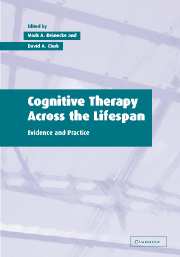Book contents
- Frontmatter
- Contents
- List of contributors
- Foreword
- 1 Cognitive therapy across the lifespan: conceptual horizons
- 2 Cognitive theory and therapy of depression
- 3 Cognitive theory and therapy of bipolar disorders
- 4 Regulation of emotion in generalized anxiety disorder
- 5 Cognitive theory and therapy of obsessions and compulsions
- 6 The cognitive model of panic
- 7 Treating obsessional problems using cognitive-behavioral therapy
- 8 Narcissistic personality disorder
- 9 Cognitive therapy and the self
- 10 Promoting cognitive change in posttraumatic stress disorder
- 11 Cognitive theory and therapy of social phobia
- 12 The cognitive model of bulimia nervosa
- 13 Cognitive therapy and schizophrenia
- 14 Cognitive-behavioral interventions for alcohol abuse and dependence
- 15 Cognitive approaches to understanding, preventing and treating child and adolescent depression
- 16 Cognitive-behavioral interventions in childhood anxiety disorders
- 17 Attention deficit/hyperactivity disorder
- 18 Cognitive-behavioral interventions for children with conduct problems
- 19 Processes of change in cognitive therapy
- 20 Cognitive therapy in the twenty-first century: current status and future directions
- Index
12 - The cognitive model of bulimia nervosa
Published online by Cambridge University Press: 05 July 2014
- Frontmatter
- Contents
- List of contributors
- Foreword
- 1 Cognitive therapy across the lifespan: conceptual horizons
- 2 Cognitive theory and therapy of depression
- 3 Cognitive theory and therapy of bipolar disorders
- 4 Regulation of emotion in generalized anxiety disorder
- 5 Cognitive theory and therapy of obsessions and compulsions
- 6 The cognitive model of panic
- 7 Treating obsessional problems using cognitive-behavioral therapy
- 8 Narcissistic personality disorder
- 9 Cognitive therapy and the self
- 10 Promoting cognitive change in posttraumatic stress disorder
- 11 Cognitive theory and therapy of social phobia
- 12 The cognitive model of bulimia nervosa
- 13 Cognitive therapy and schizophrenia
- 14 Cognitive-behavioral interventions for alcohol abuse and dependence
- 15 Cognitive approaches to understanding, preventing and treating child and adolescent depression
- 16 Cognitive-behavioral interventions in childhood anxiety disorders
- 17 Attention deficit/hyperactivity disorder
- 18 Cognitive-behavioral interventions for children with conduct problems
- 19 Processes of change in cognitive therapy
- 20 Cognitive therapy in the twenty-first century: current status and future directions
- Index
Summary
Introduction
Bulimia nervosa is a highly prevalent eating disorder that has a profound impact on the lives of many women and their families. In the first clinical account, Russell (1979) described bulimia nervosa as a separate eating disorder with key features of binge eating, accompanied by feelings of loss of control during such eating episodes, followed by guilt and remorse. A fear of fatness leads to repeated attempts to lose weight through dieting and/or inappropriate compensatory purging behaviors, e.g., self-induced vomiting, laxative or diuretic abuse, and excessive exercise. Bulimia nervosa usually arises in adolescence with peak onset at 18 years, and affects as many as 2% of young women (Mitchell et al., 1987a).
Bulimia nervosa is a major source of psychiatric morbidity and leads to impairments in several areas of physiological and psychological functioning. Clinical features include high rates of depression and anxiety, personality disorders, disturbances in social functioning, alcohol and drug abuse, and suicide attempts (Fahy and Russell, 1993). Rates of sexual abuse appear to be higher in bulimia nervosa than in other psychiatric groups (Waller, 1991), although this issue has not been sufficiently explored. Adolescents with bulimia nervosa often experience significantly lower self-esteem than those without an eating disorder (Crowther and Chernyk, 1986); they also report significantly more suicidal ideation and suicide attempts than other adolescents (H. M. Hoberman et al., unpublished data). Beyond psychiatric morbidity, preoccupation with food and body weight can impair social, school, and work functioning.
- Type
- Chapter
- Information
- Cognitive Therapy across the LifespanEvidence and Practice, pp. 293 - 314Publisher: Cambridge University PressPrint publication year: 2003

